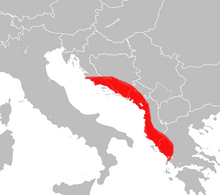Armadillidium klugii
| Armadillidium klugii | |
|---|---|
 |
|
| Rough drawing of Armadillidium klugii in rolled up position | |
| Scientific classification | |
| Kingdom: | Animalia |
| Phylum: | Arthropoda |
| Subphylum: | Crustacea |
| Class: | Malacostraca |
| Order: | Isopoda |
| Suborder: | Oniscidea |
| Family: | Armadillidiidae |
| Genus: | Armadillidium |
| Species: | A. klugii |
| Binomial name | |
|
Armadillidium klugii Brandt, 1833 |
|
 |
|
| Range | |
| Synonyms | |
|
Armadillo astriger C. Koch, 1841 |
|
Armadillo astriger C. Koch, 1841
Armadillo guttatus C. Koch, 1841
Armadillo pustulatus C. Koch, 1841
Armadillidium albanicum Verhoeff, 1901
Armadillidium inflatum Verhoeff, 1907
Armadillidium cetinjense Strouhal, 1927
Armadillidium klugii is a lesser-known, rare Balkan, Dalmatia-based species of woodlouse, most distinguished by its colouration which resembles the red markings of the Mediterranean black widow Latrodectus tredecimguttatus. This is probably a kind of mimicry, to ward off predators that mistake the harmless animal for a venomous spider.
The maximum length of Armadillidium klugii is 21 millimetres, compared to Armadillidium vulgare's 18 millimetres. Unlike the typical black color of the dorsal plates of most Armadillidium species, the general coloration of A. klugii is greyish brown, with a variable number of yellow spots, and red spots for mimicry of the Mediterranean black widow.
The range of Armadillidium klugii lies along the coastline of the Adriatic sea, spanning from north to south of former Yugoslavia. The majority of A. klugii records are clustered in Dalmatia, in the northern end of its distribution, but 5 specimens have been reported in south Albania and west Greece. It is found under stones and in crevices.
...
Wikipedia
